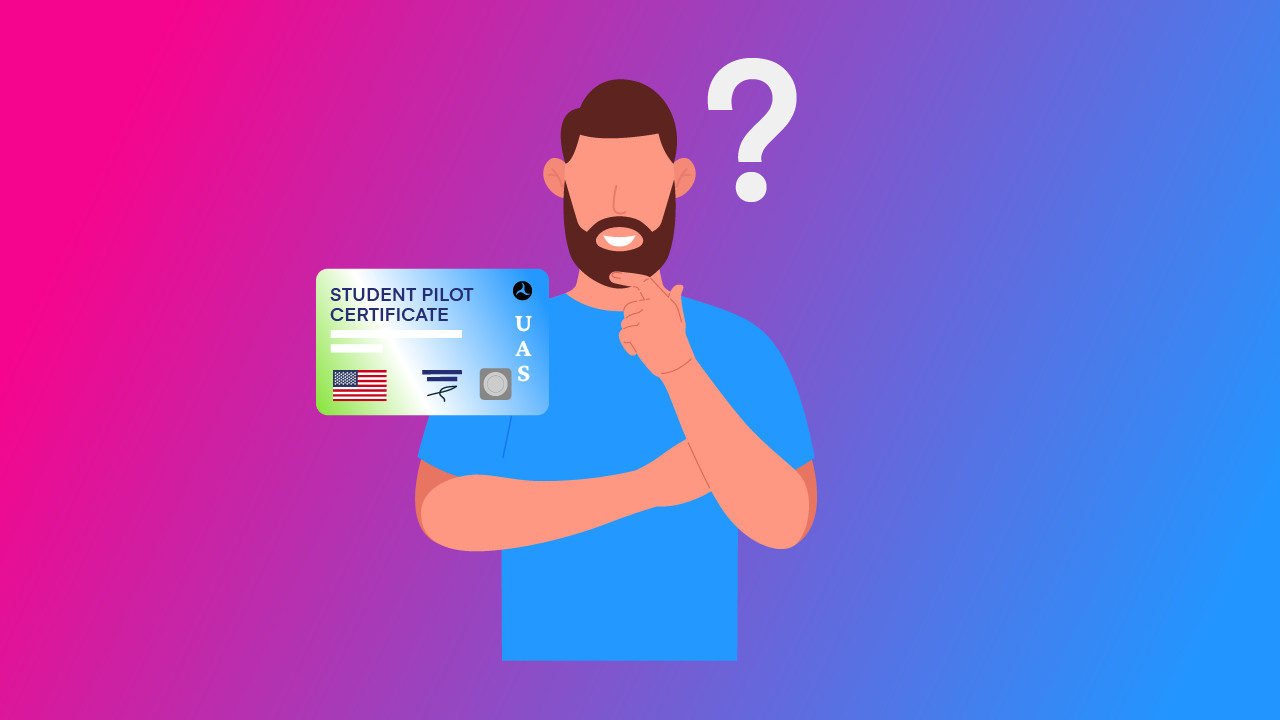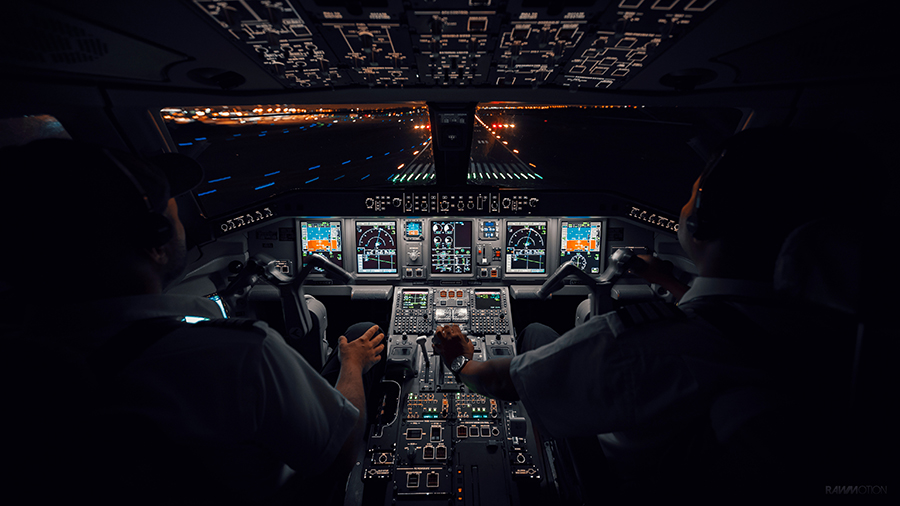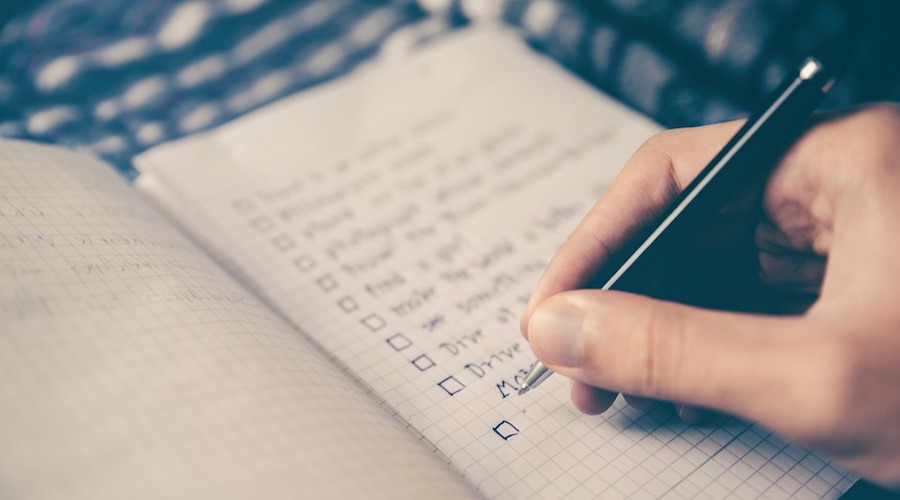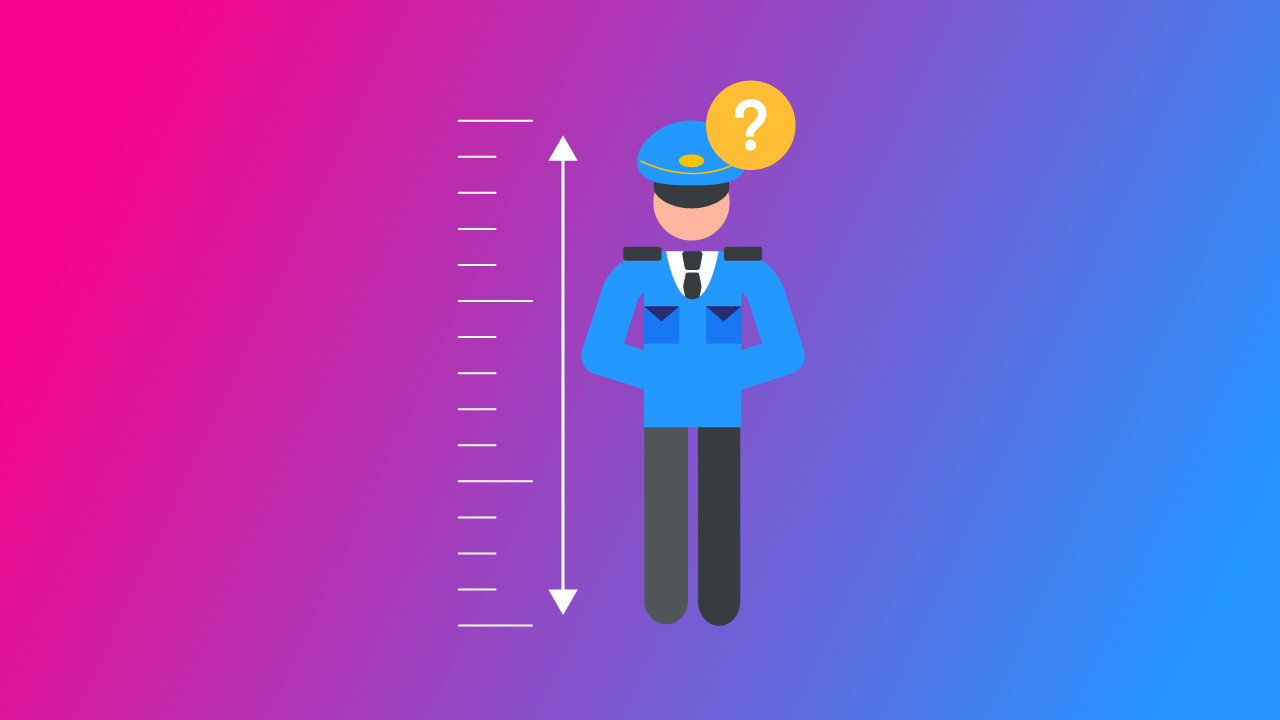-
Key Takeaways
-
1. Know Your Why
- What It Does—and Doesn’t
-
2. Student Pilot Eligibility Requirements
- Age & Language
- Citizenship & TSA Vetting
- Training vs. Certificate Timing
-
3. Secure a Medical
- Classes & Validity
- Finding an AME
- Avoid Expensive Surprises
- Can You Use BasicMed as a Student Pilot?
-
4. Application Methods
- Using IACRA (Recommended)
- Paper Fallback
- Who Can Process
-
5. Identity-Verification Session
- Bring the Right Docs
- What the Certifying Officer Does
- Fees & Etiquette
-
6. The Waiting Game
- TSA Vetting Timeline
- Downloading the Temporary Certificate
- Receiving the Plastic
-
7. Logbook Endorsements = Solo Privileges
- How Endorsements Work Post-2016
-
8. Operating Limitations Every Student Must Obey
-
9. Cost & Time Estimates
- Ways to Save
-
10. Troubleshooting & FAQs
- Driver’s License Confusion
- Failed Medical Paths
-
11. Next Milestones After Card Arrives
- First Solo Checklist
- Map Your Private Pilot Path
- Build Your Support Network
-
Conclusion
Your first solo could be next month if you file the right form today. Since 2016, the FAA has separated medical certificates from student pilot certificates, which means you’ll need to handle parallel processes before you can fly on your own.
This can feel overwhelming for new students. Are you one of them?
Well, this guide gives you a zero-surprise checklist to keep you on track. You’ll know what to expect and what to avoid. You can save money, time, and a headache.
Your path to solo flight starts here.
Key Takeaways
- A student pilot certificate allows you to solo an aircraft with an instructor endorsement.
- A third-class medical certificate is required to act as PIC except when training for glider, balloon, or sport certification.
- Student pilots can’t carry passengers, fly in IMC, operate internationally, or receive compensation.
- You can apply for a student pilot certificate through IACRA online or through a paper form.
1. Know Your Why
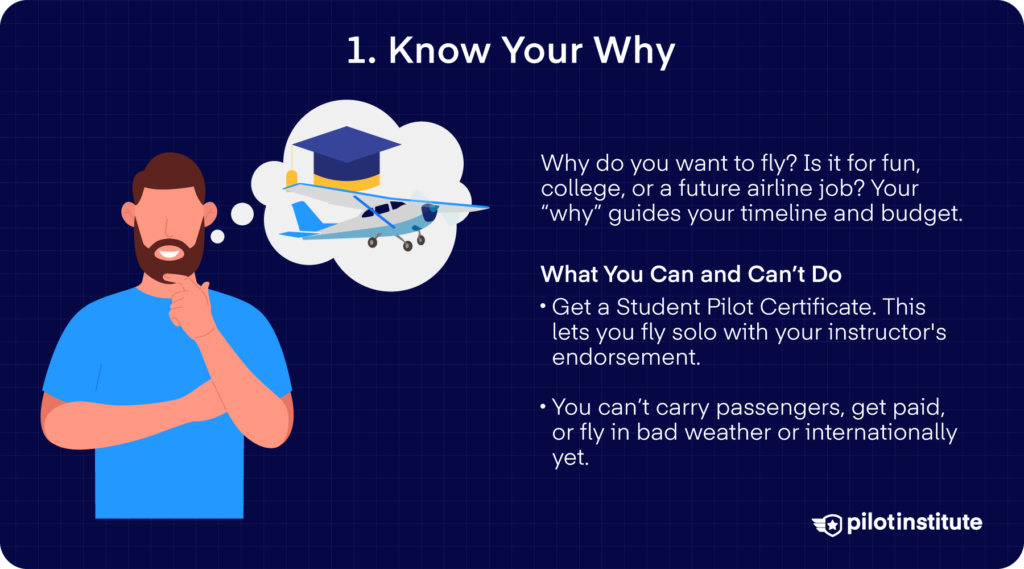
So, you’ve decided to be a pilot. That’s exciting! But before jumping into training, it really helps to ask yourself: Why do you want to fly?
Some people want to fly for recreation, for the joy of exploring new places and feeling free. Maybe you’re joining a university aviation program, or you plan to apply for flight school after your bachelor’s degree.
Then there’s the airline track. Do you see yourself flying big aircraft as a career?
The possibilities in flying are endless, and these are just a few of the many paths you can take. But no matter what your goals are, your “why” will influence how much time, money, and dedication you’ll commit.
What It Does—and Doesn’t
Whatever your endgame is, the first step is the same for everyone: get your student pilot certificate.
What does it do? The main purpose of a student pilot certificate is so that you can fly an aircraft solo, which is required for any further certification.
You’ll always be supervised by your Certified Flight Instructor (CFI). And because you’re still just a fledgling pilot, the certificate comes with some guardrails.
For example, you can’t fly as Pilot In Command (PIC) when you:
- Carry passengers.
- Fly for compensation or hire.
- Fly in furtherance of a business.
- Fly internationally (with some exceptions).
- Fly below acceptable surface visibility.
- Fly without visual reference to the surface.
2. Student Pilot Eligibility Requirements
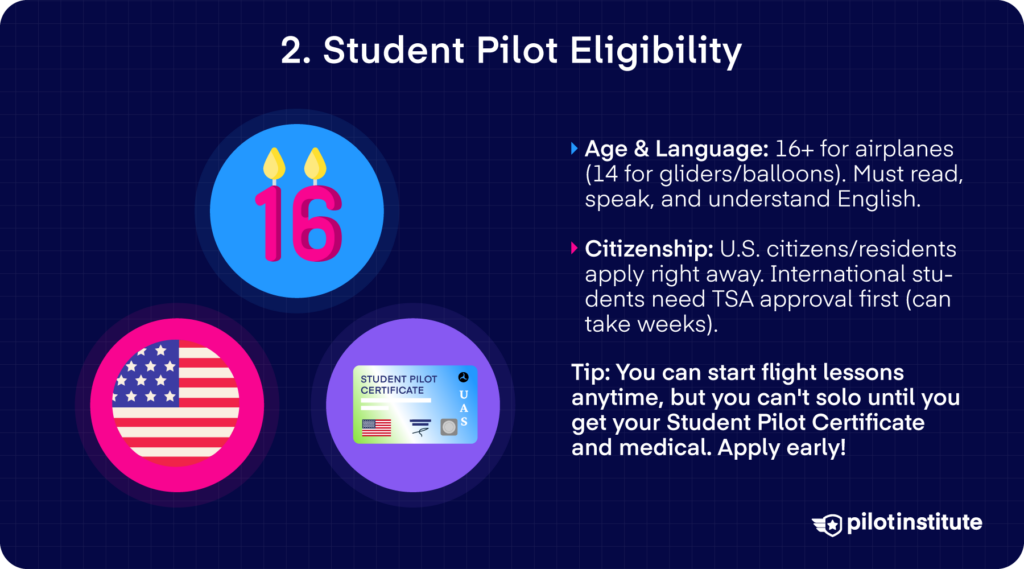
Age & Language
Before you even pick up a headset, the FAA expects you to meet basic age and language criteria.
You must be at least 16 years old to receive a student pilot certificate for powered aircraft, such as airplanes. And if you’re flying a glider or balloon, the minimum drops to 14 years old.
Also, you need to be able to read, speak, write, and understand English . That requirement makes sure you can read charts and communicate with Air Traffic Control (ATC).
Citizenship & TSA Vetting
If you’re a U.S. citizen or permanent resident, the path is more straightforward. You fill out the application, get vetted, and proceed.
Many international students also come to the US to train all the time. Are you one of them? If so, then there’ll just be one extra step.
Before starting your training, you need TSA approval through their Flight Training Security Program (FTSP) . You can start this process through the FTSP portal.
Once you’re cleared, you’ll get a Determination of Eligibility .
The process can add weeks to your timeline. If you’re an international student, you’ll want to start that process early, ideally even before your first lessons.
Training vs. Certificate Timing
Here’s one thing to remember: you don’t technically need that plastic student certificate in hand to start your dual lessons. You can start flight training anytime you like.
But what does require the student certificate is your solo flights. You might log dozens of hours learning with an instructor, but you can’t fly solo without it.
So, as soon as everything lines up, start making arrangements to be cleared for that first solo.
3. Secure a Medical
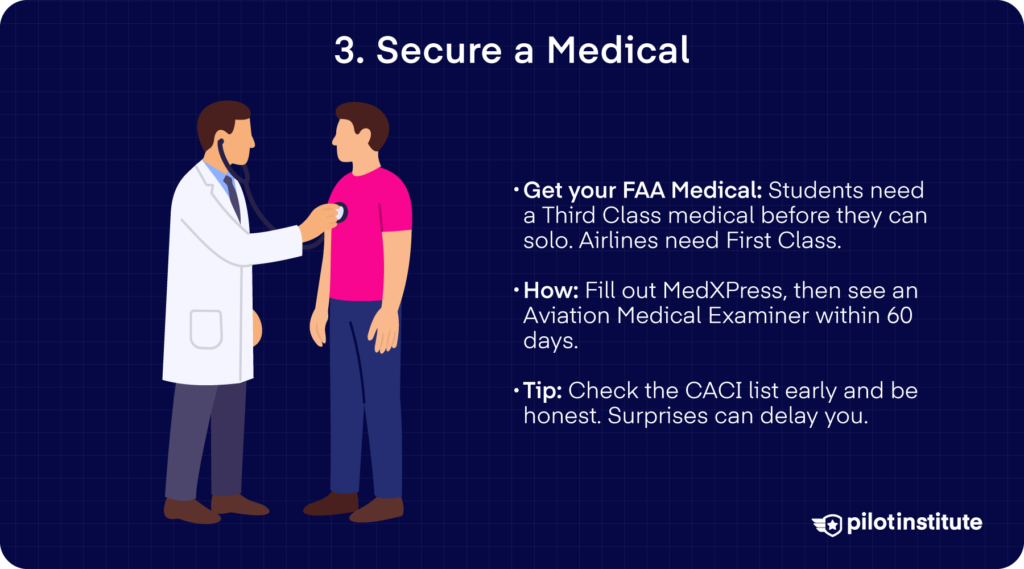
Classes & Validity
The FAA issues three classes of medical certificates: first, second, and third. Most student pilots aim for a third-class medical since it’s the least stringent, and it generally satisfies the requirement to solo.
But if your dream is to fly for the airlines someday, it could be a smart move to get a first-class medical as soon as now.
How come? It can reveal any health issues that a third-class exam might miss. You wouldn’t want to discover any disqualifying conditions only after having invested so much.
A medical certificate is not permanent, and it’s valid for only a limited time depending on its class. Here’s a simplified table:
| Medical Certificate Class | How long is it valid? | |
| If you’re under age 40 | If you’re 40 years old or older | |
| First Class | 60 months for a student pilot certificate. 12 months for an ATP certificate | 24 months for a student pilot certificate. 6 months for an ATP certificate |
| Second Class | 60 months for a student pilot certificate. 12 months for a commercial pilot certificate | 24 months for a student pilot certificate. 12 months for a commercial pilot certificate |
| Third Class | 60 months for a student pilot and a private pilot certificate | 24 months for a student pilot and a private pilot certificate |
Finding an AME
You’ll use the FAA’s MedXPress system to get your medical certificate. You fill out the application online, answer medical history questions, and then you receive a confirmation number.
Next, you’ll have to schedule an appointment with an Aviation Medical Examiner (AME). To find a qualified medical examiner, use the FAA’s AME locator tool on the FAA website.
Take note that you have to complete the exam within 60 days of your application. Schedule your AME appointment early to stay on the safe side.
You’ll need to have your confirmation with you on exam day. Also, do you have any current or past medical conditions? Do you take medication? You may need to bring additional medical records.
Look up the requirements for medical certification in the Guide for Aviation Medical Examiners. You’ll find helpful details to guide you and your doctor in gathering what the FAA needs.
There will be tests for your vision, ENT, medical history, and mental health. Be honest and complete when the AME asks questions. Withholding information often backfires in the end.
Avoid Expensive Surprises
Here’s a heads-up: imagine you’ve spent 15 hours of dual instruction, you’re ready to solo, but your medical exam is deferred or denied. All because you once took ADHD medication.
You don’t want your medical history to derail your training, so here’s what you can do.
The FAA uses a system known as CACI (“Conditions AMEs Can Issue”) to handle many routine conditions if they meet the criteria.
If you satisfy all the requirements, the AME can issue your medical without sending it off to the FAA.
If you have conditions that need special review or are outside CACI, your medical could be deferred. In that case, the FAA will have to review your case more thoroughly.
Can You Use BasicMed as a Student Pilot?
So, the short answer is yes, but only if you’ve already held an FAA medical at any time after July 14, 2006, and you complete the BasicMed exam and online course.
If you’ve never held a medical, get a third-class first. After that, you can solo and take your checkride under BasicMed within its limits.
4. Application Methods
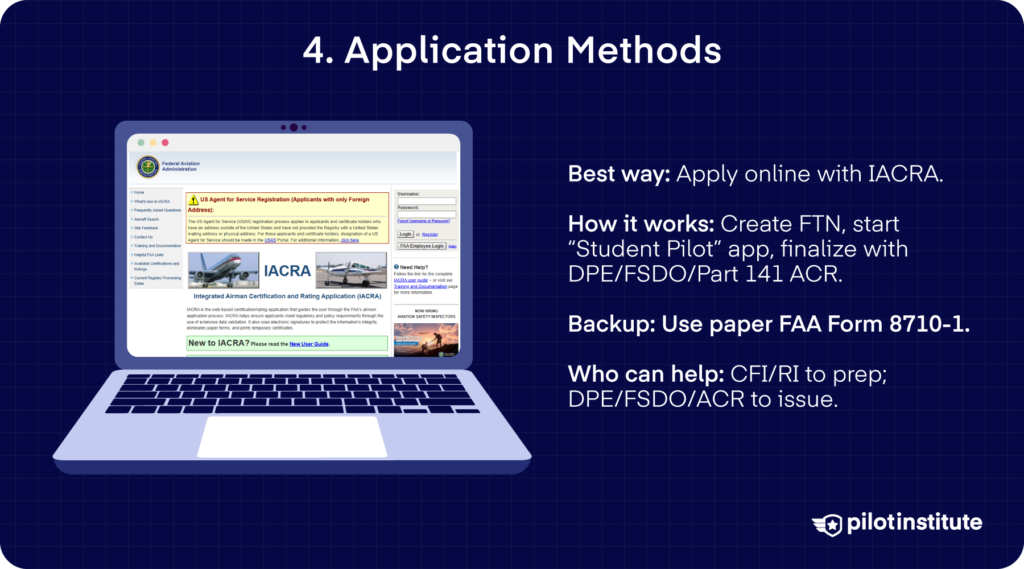
You have two paths when you’re ready to apply for your student pilot certificate: the online IACRA system or the older paper fallback.
Using IACRA (Recommended)
Which one do we recommend? The IACRA (Integrated Airman Certification and Rating Application) system. Going digital helps you avoid errors that often delay paper forms.
How does it work? First, you sign up and create your FTN (Federal Tracking Number). Your FTN will serve as your unique identifier in the FAA’s records throughout your whole career, so keep hold of it.
We suggest that you screenshot your Application ID and FTN right away. If you ever have login trouble, having this information will help re-locate your application.
Once that’s done, log back into IACRA under your FTN. Click on “Start New Application” and select “Student Pilot”. It will bring you to a page where you’ll fill in a couple more personal details and flight information.
The application process isn’t done yet after filling out your part. You have to meet with your CFI (in this context called a Recommending Instructor), or a Certifying Officer (CO). We’ll talk more about this in step five.
Paper Fallback
Is your internet access too unreliable? Then you can use the paper method, but only as a last resort. Be warned that it brings more risk of clerical errors or missing fields, which can add unnecessary hassle.
You can download FAA Form 8710-1 (Airman Certificate and/or Rating Application) from the official FAA site. Fill it out legibly in blue or black ink, then have your RI validate and sign it.
Who Can Process
Who can handle your application? Well, you have a few options:
- CFI as a Recommending Instructor (RI).
- Designated Pilot Examiner (DPE).
- Your local FSDO.
- Airman Certification Representative (ACR) associated with a Part 141 flight school.
5. Identity-Verification Session
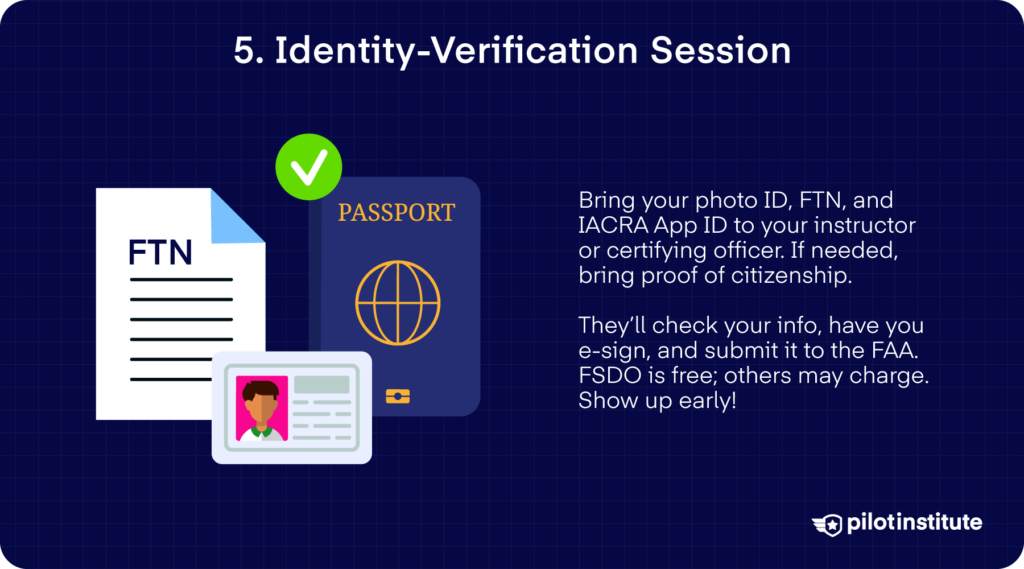
You’ve filled out your part in the application form, and now it’s time to meet with your recommending instructor. What goes on at this stage, and how can you prepare?
Bring the Right Docs
First, you need to have the required documents ready.
You’ll want to show up with a government-issued photo ID, such as a driver’s license or passport. Bring your FTN and Application ID from IACRA as well.
You may also need to carry proof of citizenship, like a birth certificate, passport, or naturalization certificate, in case the RI requires it.
What the Certifying Officer Does
The certifier will make sure your ID matches your application and that you meet the eligibility criteria. This is where they’ll review your application details together.
You’ll electronically sign the application, then the RI will complete their portion. This seals the application so it can’t be changed.
Last step, your application is forwarded to the FAA’s Airmen Certification Branch for processing.
Fees & Etiquette
How much cash should you have ready? Well, there’ll be no charge if you take your application to an FSDO.
However, authorized parties like a CFI, DPE, or ACR may charge a reasonable fee for their administrative work. This fee can vary depending on the individual and location.
The most important thing to bring is your professionalism. Politeness and punctuality go a long way, even as a student pilot. Show up early and have everything neatly organized.
6. The Waiting Game
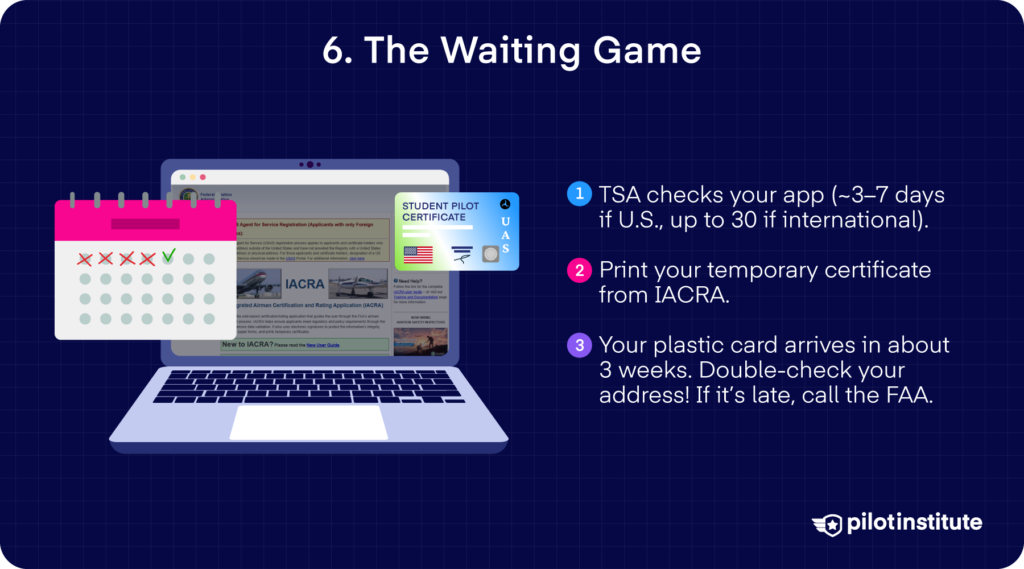
You’ve submitted all your requirements to the FAA, so what’s next? It’s time for the waiting game.
TSA Vetting Timeline
Once your application is complete, the TSA steps in for a security vetting before the FAA issues your student pilot certificate.
For U.S. citizens, that vetting often takes about 3 to 7 days. If you’re a non-U.S. citizen, it can stretch up to 30 days or more.
Downloading the Temporary Certificate
So, your application cleared the security review, and the FAA has given the green light. Congratulations!
Just log into IACRA, head to your Applicant Console, and look for the option to “View/Print” or “View Temporary Certificate”.
With a few clicks, you can pull up your temporary student pilot certificate and print it right away.
Receiving the Plastic
Your permanent “plastic” student pilot certificate is mailed out by the FAA’s Airmen Certification Branch. If everything goes smoothly, it should arrive in about three weeks!
The FAA will mail your permanent certificate to the address you provided in your application. It is important to double-check that your mailing address is correct in your IACRA/FAA records to prevent delays.
If the plastic card does get lost or delayed, you can call the FAA Airmen Certification Branch for status or replacement. Their contact lines are: (866) 878-2498 (toll-free) or (405) 954-3261 (local in the Oklahoma City area).
7. Logbook Endorsements = Solo Privileges
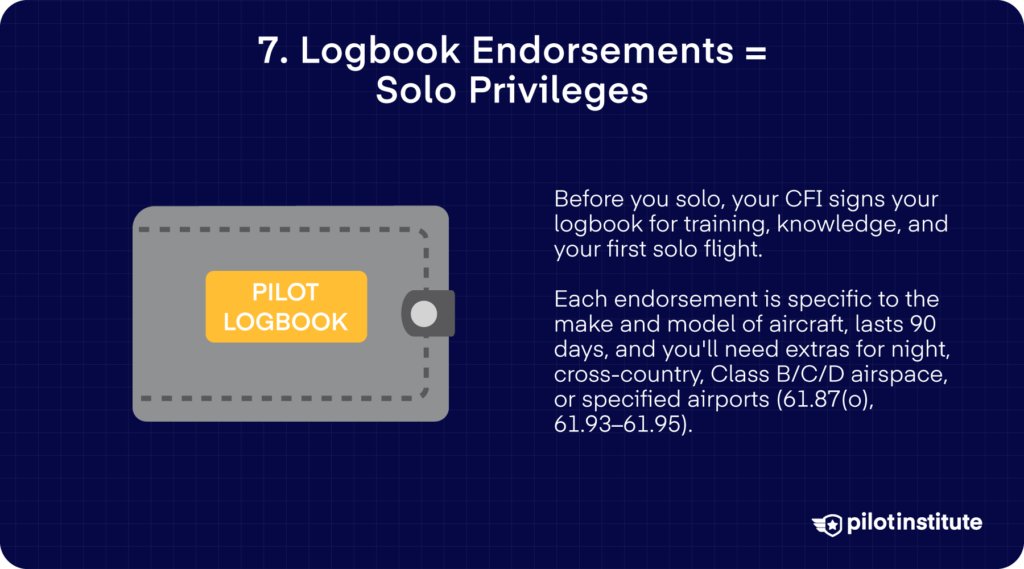
You finally have that certificate in your hands. Are you ready for that first solo? Hold on just a sec. Your first solo is a very exciting milestone, but you want to make sure you’re doing it legally.
How Endorsements Work Post-2016
Remember that your instructor has to give their logbook endorsement first. They have to attest that you have the knowledge and that you’ve received flight training to fly solo.
On top of that, you can only fly in the specific make and model of aircraft you’re endorsed for, and only within 90 days.
What happens after the time limit? Your instructor just needs to update their logbook endorsement.
Do you want to fly at night, cross-country, or in towered airspace? You’ll need specific training and endorsement for those, too.
In short, you need three CFI endorsements in your logbook: pre-solo knowledge, pre-solo flight training, and initial solo endorsement.
You’ll also need a separate endorsement for certain flight operations. And every time you solo, your logbook must show a valid instructor endorsement for that specific make and model of aircraft that is not older than 90 days.
You will also need separate endorsements for certain flight operations. These have their own specific requirements and validity periods.
8. Operating Limitations Every Student Must Obey
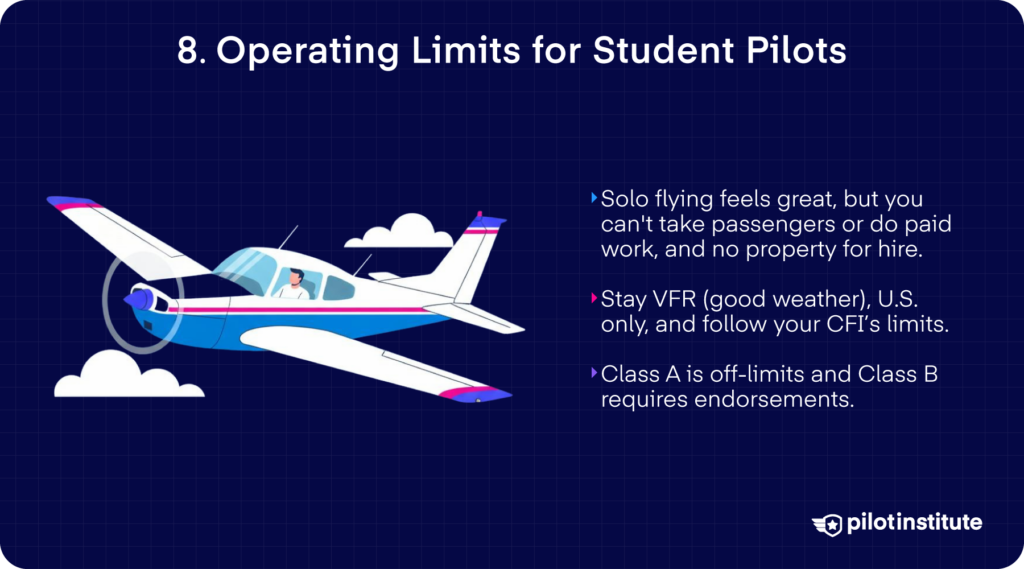
Soloing is one of the biggest milestones in your flight training. It feels like pure freedom, but still under certain conditions.
Let’s start with the obvious: no passengers. Along the same lines, you can’t use those solo privileges to haul cargo or act as a paid pilot.
You’re also bound by weather restrictions. Every flight as PIC must stay under visual flight rules. You need to keep the ground in sight and stay clear of the clouds.
The minimum visibility is three statute miles in the daytime and five statute miles at night. If conditions fall below that, you’ll need to wait it out on the ground.
Another limit is geography. Student pilots generally can’t fly outside the U.S.
There’s one tiny carve-out in Alaska for flights between certain towns and Whitehorse, Canada. But unless you’re training there, international flights are off the table.
Your instructor’s word is law, too. If they set specific limits in your logbook, those become part of your legal boundaries.
Airspace restrictions round out the list. Class A is off-limits entirely, and Class B requires special training and a separate endorsement just to enter.
9. Cost & Time Estimates
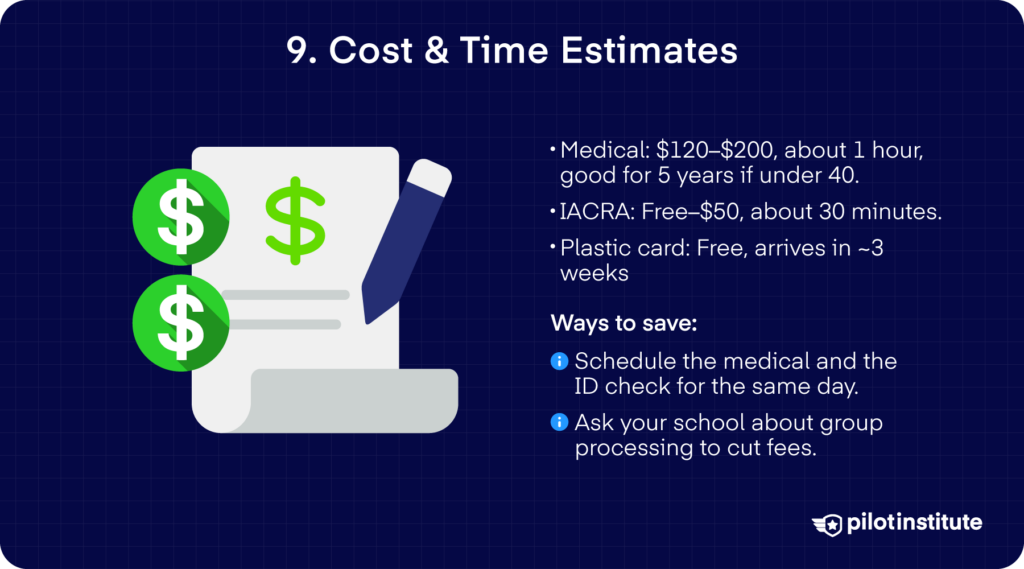
Here’s what you can expect to pay and how long each step might take as you work toward getting your student pilot certificate.
| Task | Typical Cost | Time | Notes |
| Medical (Class 3) | $120–$200 | ~1 hr + forms | Valid 60 months if below 40 years old |
| IACRA Processing | Free–$50 | ~30 min | Depends on CI fee |
| Plastic Card | Free | ~3 weeks mail | Temporary certificate usable before the plastic card arrives |
Ways to Save
Can you squeeze in a few shortcuts to save hassle and cost? Absolutely!
For example, try to schedule your flight physical exam and your CFI identity-verification session on the same day at the same airport. You save on travel, time, and logistics.
Another tip: if your flight school has an Airman Certification Representative (ACR), they could process student certificate applications in a batch. You’ll have to go through less administrative work and per-student overhead fees.
10. Troubleshooting & FAQs
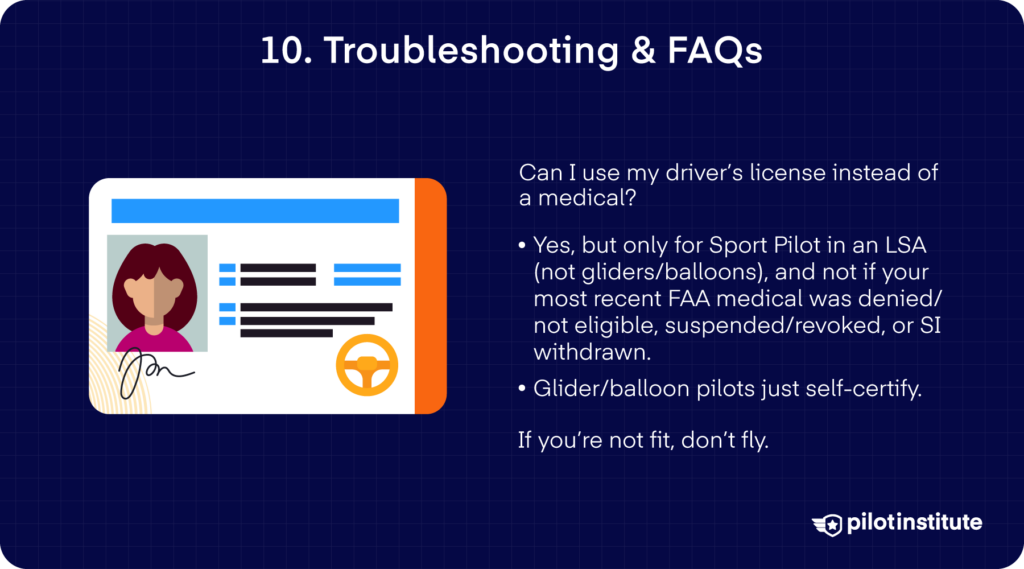
Driver’s License Confusion
You might have heard how some pilots use their driver’s license in place of their medical. Can you do this, too?
Well, the short answer is: it depends. A driver’s license doesn’t substitute for the medical certificate required if you’re seeking a private pilot certificate or higher.
There are some special cases, however. If you’re training for a sport pilot certificate in a light-sport aircraft (other than a glider or balloon), then yes! You can use a valid U.S. driver’s license in place of the medical.
Just keep in mind that it comes with certain conditions. You must follow any restrictions printed on your driver’s license, as well as any court or agency orders that limit your ability to drive.
If you’ve ever applied for an FAA medical in the past, you must have been found eligible for at least third-class. You also can’t have had your most recent medical certificate suspended or revoked, or a special issuance withdrawn.
That’s why many people who plan to be a sport pilot just don’t apply for a medical at all. There’s no risk of being denied. They preserve the option of using their driver’s license without risking a medical denial that would shut that path.
Failed Medical Paths
But what if you’ve had your medical certificate denied or revoked? No need to worry, all hope is not lost.
You don’t need to hold an FAA medical certificate to become a glider and balloon pilot. In fact, you don’t even need a driver’s license! Instead, you just need to sign a statement declaring you know of no medical defect that could risk safety.
If you feel confident in your health, you can legally fly gliders and balloons.
But of course, this also means the weight of responsibility is heavier. If you push yourself to fly when unfit, the consequences will rest squarely on your shoulders. Exercise your judgment and discretion truthfully and wisely.
11. Next Milestones After Card Arrives
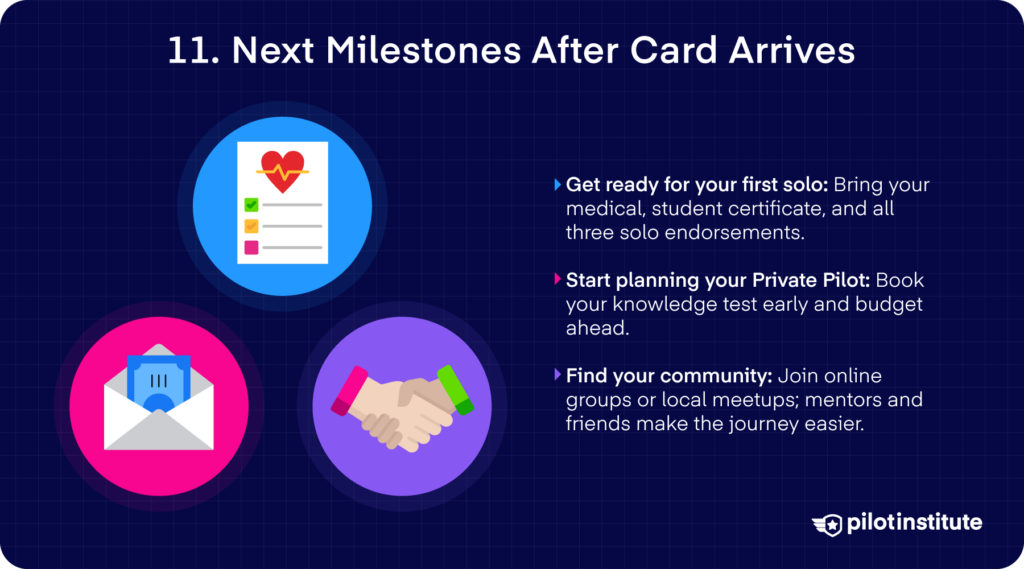
First Solo Checklist
You’re finally ready to fly solo. But before heading to the aircraft, which items do you need to have?
Don’t forget to secure:
- A valid medical certificate (or a driver’s license, or your signed statement, depending on the certificate you’re training for).
- Your temporary or permanent student certificate.
- Three current logbook endorsements for:
- Pre-solo aeronautical knowledge.
- Pre-solo flight training.
- Initial solo in the make and model of your aircraft.
Map Your Private Pilot Path
What comes next? Well, it’s up to you! But for most pilots, the next target is the Private Pilot Certificate.
If this is your next target, we suggest that you schedule your knowledge test early, even before finishing all your flight hours. You can apply what you learned immediately in the cockpit, and your training won’t stall waiting for test prep.
In terms of cost, many flight training programs in the U.S. tend to cost somewhere between US$8,000 and US$28,000 for a private pilot certification.
But truly, it can vary widely depending on aircraft rates, instructor fees, location, and how efficiently you fly.
Build Your Support Network
The scary part of the phrase “flying solo” is that second word, but that doesn’t mean you have to go through it alone. A strong support network will push you forward and help you when you hit obstacles.
Some online ground schools have study groups where you can learn with other pilots. At the same time, you’ll go through full courses to prepare for the FAA written exam.
You can also connect with youth or outreach programs like EAA Young Eagles. They often pair new student pilots with mentors and community events.
And who knows? There could be networking opportunities just nearby. Check if there are pilot meetups, fly-in breakfasts, or airport open houses in your area.
Having a community can open all sorts of doors for your career. But best of all, it gives you a sense of belonging in your chosen path.
Conclusion
You now understand the process, the requirements, and the privileges that come with this milestone. From here, the path to your first solo (and eventually, further certification) is within reach.
Stay organized, start booking those appointments, and surround yourself with a supportive community of aviators.
But most importantly, never lose sight of why you started. The sky is waiting, and every lesson brings you closer to the freedom of flight. Your cockpit seat is ready, so start today.
